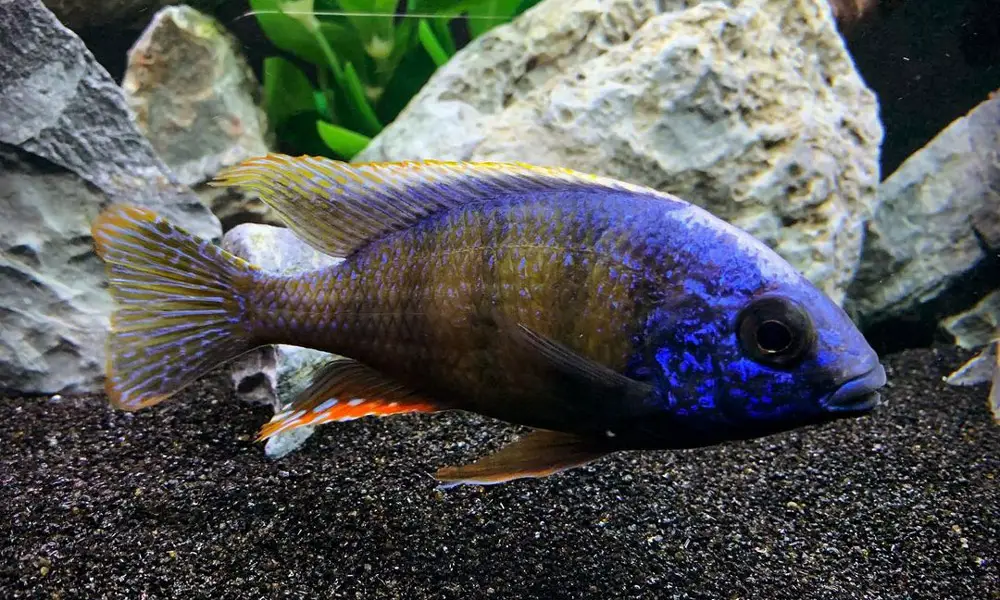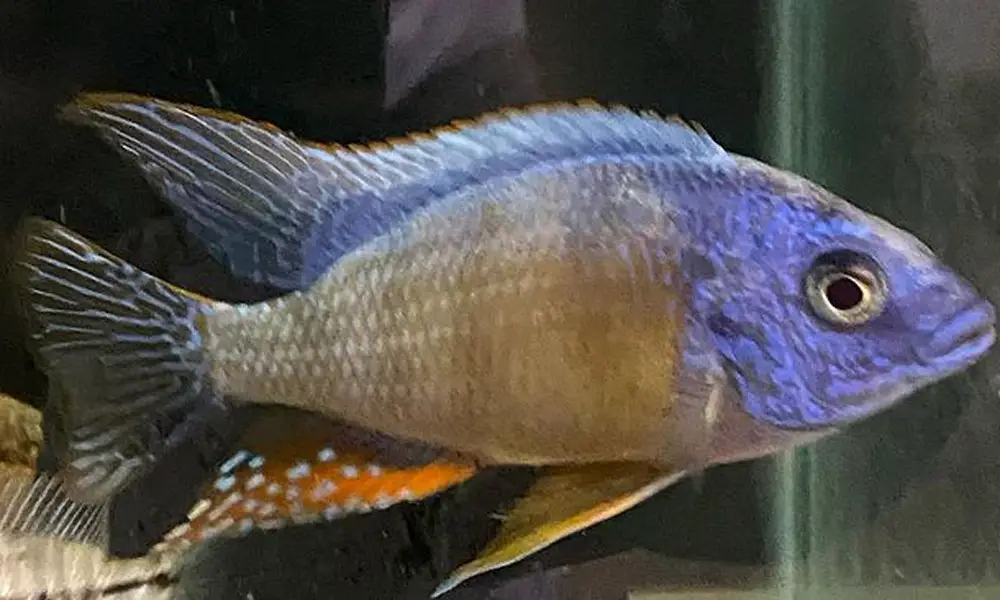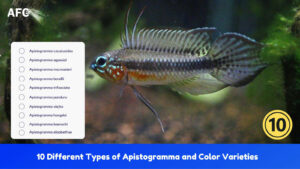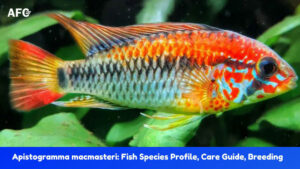Counted among the highly desirable Hap among the fishkeepers, Taiwan Reef Cichlid is no less than a treat for an eye. These stunning African cichlids are famous for their metallic blue heads, which sets them apart from all other fishes in your tank.
Not only do they look interesting, but they are hardy and relatively peaceful, which makes them ideal for any Peacock and Hap tank. However, keep in mind that they are a little clumsy and can get scratched easily, so be careful while handling them.
Below you’ll learn all you need to know about Taiwan Reef Cichlid care. We have covered their diet, tank mates, breeding, and lifespan so that you can make an informed decision before bringing them home.
Let’s get started!
Species Summary
Also known as Protomelas sp. Steveni Taiwan and Taiwan Reef steveni, the Taiwan reef cichlid is an undescribed species from Lake Malawi. This vibrant and lively fish is named after where it was first collected, Taiwan Reef, or more accurately, Taiwanee Reef. The term “Taiwanee” locally means “lost child.” Besides, it’s also found in other areas, including Mbamba (Ngkuyo) Bay as well as Higga Reef in Tanzania.
This species belongs to the Protomelas genus, which contains 16 recognized species. Most members are sexually dimorphic and maternal mouthbrooders.
Some of the more famous close relatives in the aquarium hobby include:
- P. taeniolatus (Red Empress)
- P. fenestratus (Fenestratus hap)
- P. dejunctus (Fire blue hap)
- P. insignis (one-and-a-half-stripe hap)
In their natural habits, these fish inhabit sediment-free rocky areas with plenty of open swimming space, where they mainly feed on algae and a variety of small invertebrates.
| Scientific Name: | Protomelas sp. Steveni Taiwan |
| Common Name: | Taiwan Reef Cichlid, Taiwan Reef steveni |
| Origin: | Lake Malawi |
| Care Level: | Advanced |
| Lifespan: | 5 years |
| Max Size: | 8 inches (20cm) |
| pH: | 7.5 to 8.4 |
| Temperature: | 74 – 82F |
| KH: | 4 to 8 KH |
| Minimum tank size: | 75 gallons |
| Diet: | Omnivorous |
Appearance

This cichlid is widely applauded for its beautiful and vibrant hues. Although it is a Hap, Taiwan Reef looks more identical to peacock cichlids with a fuller and shorter body rather than the typical streamlined shape of other Haps.
Their body colors are usually red, blue, and yellow, accompanied by a white stripe across the top of their head and dorsal fin. The anal and pelvic fins are covered in red. The white-bluish blaze on their head makes them different from other species.
This is a sexually dimorphic species; hence, identifying males and females is pretty simple. The matured males display bright colors with a gold flank and belly as well as a distinct lavender-blue on their head and back, while females remain silver-colored bodies with six or seven broad vertical bars and some small dots below the dorsal fin. Males will also grow to be larger than females.
It’s a worthing note that the Taiwan reef cichlid is an extremely late bloomer. It usually can take up to two years for males to develop their full colors. They start showing their unique blue hue in the head at 2 inches.
Taiwan Reef Cichlid Size
Taiwan reef cichlids can attain a maximum size of 8 inches (20cm) in length in the wild but can grow a bit smaller in the aquarium. Males can grow around 6 to 7 inches, with females can reach up to 4.5 to 5 inches.
They are not fast-growing fish. Generally, they can reach their full size in 1.5-2 years.
Like all other species, their size and growth rate also depend on the quality of care you are offering. It can be possible for them to end up smaller if they receive poor care and an inappropriate diet.
Lifespan
In captivity, the average lifespan of a Taiwan reef cichlid is 5 years. However, these fish can live 7 to 10 years with optimal care.
Taiwan Reef Cichlid Care

The best thing about keeping Taiwan Reef Cichlid is that they don’t require much attention and care. Keep them in ideal tank conditions and feed them a good diet to let them thrive.
They prefer minding their own business and never interfering with other tank mates. However, despite their hardy nature, fishkeepers should have to offer the minimum care to keep them happy and healthy.
Here’re some guidelines to follow.
Tank Size
We recommend a tank size of at least 75 gallons (48″ x 18″ x 21″) for a small group of Taiwan reef cichlids. A bigger tank is always better as it will provide more swimming space and allow you to keep other fish with them.
You might be able to get away with a smaller tank if you’re only keeping a pair. In this case, a 40-gallon long tank (48″ x 12″ x 16″) should do the job, but we don’t recommend it.
Water Parameters
These fish tail from the second deepest lake in Africa. Due to the unique environments of their natural habitat, stick to the ideal water conditions if you genuinely want these species to thrive in your aquarium.
The rivers that flow into Lake Malawi have high mineral content, so the water in the lake is alkaline and hard. Taiwan reef cichlids are used to these water parameters and will do best in similar conditions in your aquarium.
These are highly susceptible to poor tank conditions. Like most Protomelas species, it is a greedy fish and will stuff its face with everything you put in the tank, so uneaten food and waste can quickly pollute the water and cause problems. A powerful filtration system is a must.
Do a 20-50% water change weekly and vacuum the gravel to remove any uneaten food and waste, depending on your bio load. Also, sudden changes in water chemistry should be avoided at any cost.
Here’re given certain parameters that you should strictly follow before adding these cichlids to your tank.
- pH: 7.5 to 8.4
- Temperature: 74 – 82F
- Hardness: 4 to 8 KH
- Nitrates: 0
- Nitrites: 0
- Nitrate: <20 ppm
They come from very clear water, so it’s smart to invest in a surface skimmer that will help you to remove the waste and other debris from the water before it has a chance to decompose and pollute the water.
Decor (Plant and Substrate)
As for decor, simulating the natural environment of Taiwan reef cichlids is the key to success. They come from rocky shores with plenty of caves, so it’s essential to provide them with similar surroundings in your aquarium.
Use smooth rocks to create caves and hiding places for your fish. A sandy substrate is preferred. Sometimes, they may sift through the sand for food.
Live plants are not necessary, but you can add them if you want.
Food
Feeding these species is not a strenuous task. Algae form the majority of their diet in the wild; It is advised to offer them something they love to feed on. They are herbivores and readily accept food rich in high vegetable matter.
Feed them with commercial cichlid pellets and high-quality flakes. Spirulina algae should be their staple food. Remember that, like other Protomelas species, they are also greedy and have a hearty diet. So, do not overfeed them to avoid digestive concerns later on.
- New Life Spectrum is made from quality natural ingredients
- Extreme Color enhancement and vitality in your fish
- Made in the USA
Taiwan Reef Cichlid Tank Mates
In Lake Malawi, they are found in loose groups of less than 25 individuals in shallower water.
You can also keep them in a group of 8-12 individuals in a specie only tank to keep their aggression in control. But, they do well with other Peacocks and Haps of similar size and temperament.
Taiwan Reef Cichlids are mildly aggressive, but they are a little clumsy. You can also keep them with mildly aggressive mbuna in the same tank. However, it is only recommended your tank is large enough for each fish to have its own territory.
If you really want to include catfish, choose the bigger and more robust species from Lake Tanganyika, like Synodontis multipunctatus.
Here are some possible tank mates for the Taiwan reef cichlid.
- Copadichromis azureus (Azureus Cichlid)
- Copadichromis borleyi (Redfin hap)
- Copadichromis chrysonotus (White Blaze)
- Cyrtocara moorii (Blue Dolphin Cichlid)
- Otopharynx lithobates (Sulphur-headed Hap)
- Synodontis multipunctatus (cuckoo catfish)
Breeding
Like most of the other African cichlids in Lake Malawi, Protomelas sp. Steveni Taiwan are mouthbrooders. They reach their maturity around 2.5 to 3 inches.
Interestedly, they are quite prolific and breed like rats. However, it’s hard to breed this species if it is not the dominant fish in the tank. Therefore, it’s recommended to set up a separate breeding tank with one male and several females to divide the male’s attention between the females. Make sure there is plenty of hiding places and caves for the females to shelter.
The male will become more aggressive and intense in coloration when it’s time to spawn. He will try to lure the female into his cave and then fertilize her eggs. After that, the female will scoop them into her mouth and incubate them for 21-28 days.
The fry are extremely small but growing fast. You can feed them with newly hatched brine shrimp to boost their growth. They can reach about one-half inch in 4-5 weeks.
Final Thoughts
We hope our detailed Taiwan Reef Cichlid guide will help you get familiar with the basic care fundamentals so you can make the best decision. Although they are mildly aggressive cichlids, caring for them is not much hassle.
All you have to do is place them with the right tank mates and replicate their natural habitat as much as possible to make them feel comfy. It’s no denying that once they get mature, they will be one of the stars of your tank.
Their active nature and unique coloration make them fun to spectate. So, what keeps you waiting now? Give Taiwan reef cichlids a chance, and you will not regret it!






